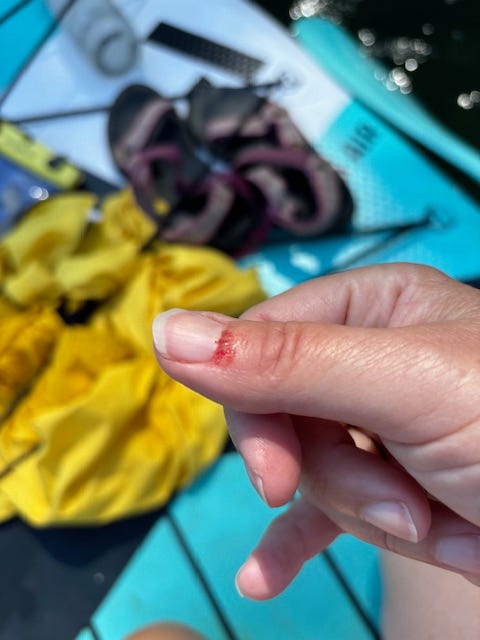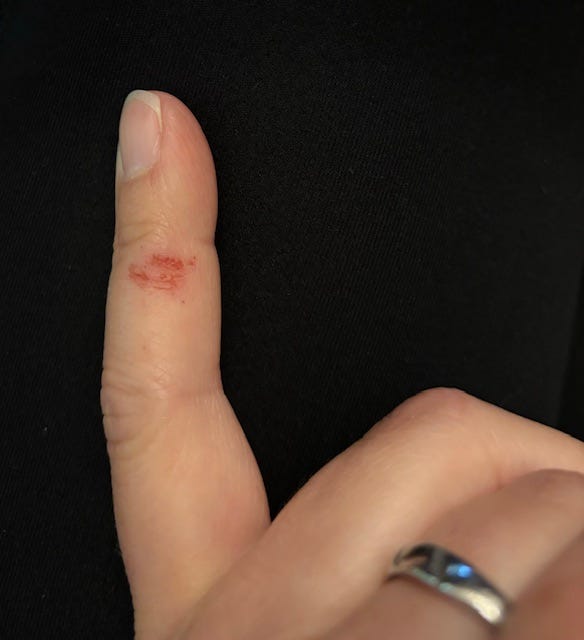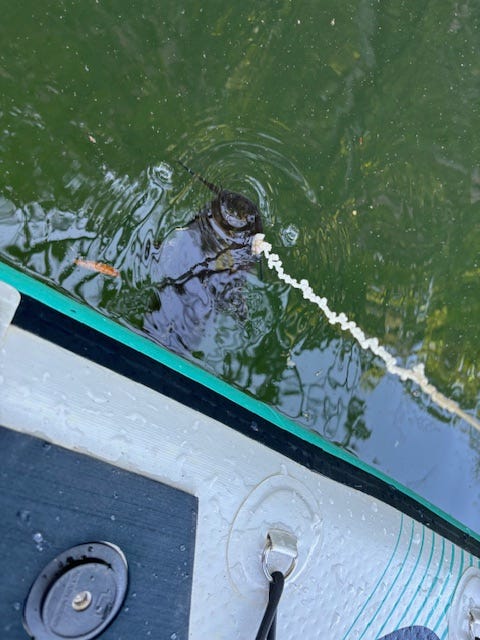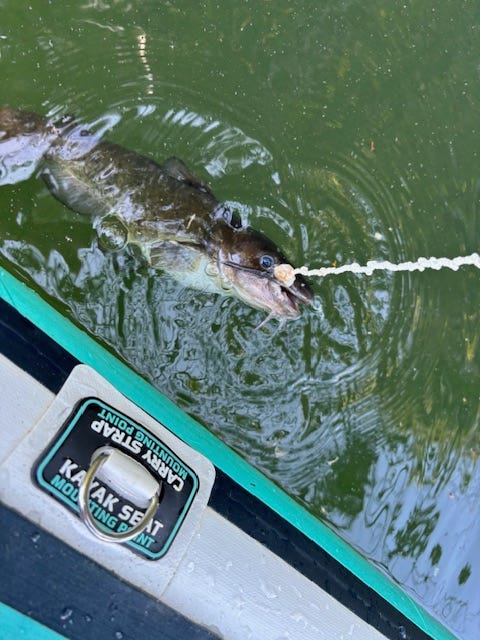Catfish have surprisingly sharp teeth and a terrifying jaw strength. Ask me how I know.
A few days ago, it was a classic spring day, too beautiful to spend indoors cleaning house, so I decided to head out for a solo mountain bike/paddleboard combo. The bike ride was great but unremarkable other than the enormous turkey that flew overhead looking like an inflated red-tailed hawk in the treetops.
The paddleboarding was a different story, however.
Every May I like to paddle a nearby wild lake because it is practically uninhabited and rimmed with mountain laurel and rhododendron growing down to the water’s edge. Two small creeks empty directly into the lake via waterfalls. It’s an incredibly soothing way to spend an afternoon.


But this year there was very little that felt soothing about the lake.
For one, I was about a week early for the mountain laurel bloom and the rhododendrons hadn’t even started. Also, the wind was gusting in bursts that threatened to knock me off my board. At one point my hat flew off my head and I had to frantically backpaddle to retrieve it.
But still, I persevered – I’d taken 15 minutes to get the board unloaded and inflated, so I was NOT going to pack it up after just 5 minutes on the water. I pushed against the wind, up the lake, searching for blooms and paddling like mad to make progress.
That’s when I saw a small cherry tree leaning over the water and below it, movement and thrashing. As I gently paddled closer, I saw a fish circling below a white string dangling from the tree, belly flashing before attempting to head to deeper water. It was a catfish, caught on a hook that someone had left in the water.
The fish was exhausted, having swam in circles so long the string was kinked into spirals. As I pulled on the line, it wildly eyed me and thrashed with renewed effort.
What should I do? I didn’t think I could just paddle off and leave it to suffer there. I looked all over my paddleboard for something sharp, but the lack of jagged objects on an inflatable vessel was probably by design. Even my car key was the folding type with no sharp edges.
I tried to chew through the string for several minutes, but all that did was roll the string around a bit and make me worry about the lake germs I was probably ingesting.
There was one other option – I could try to get the hook out. But don’t catfish whiskers have venom or something that stings? Maybe the hook was on the edge of its mouth and I could just slide it out. I thought back to the last time I handled a fish – I was probably in elementary school and even then, I think my dad unhooked any fish I caught. There’s a reason I’m not a fisherwoman…
I took a big breath and dragged the catfish onto my board. Luckily, I’d brought a windbreaker so I used that to hold the slimy, slightly-square bodied fish down and tentatively grabbed hold of the string. The fish was so exhausted it laid on the board, whiskers back against its body, while I peered down its gullet.
The hook – it was WAY down the fish’s throat, so far I could barely see it. I took a big breath and pushed my fingers into the fish. I still couldn’t feel the hook. How far could I shove my – BAM! Suddenly, the catfish clamped down on my fingers with surprising strength, I screamed and jerked my hand away, but the fish came with it, dangling from my arm as I thrashed about trying to get it off.
It finally dropped off beside my board, leaving my finger and thumb with small ragged, bleeding wounds and my resolve depleted. I wasn’t sticking my finger into that catfish again.
The only other option was to untie the hook from the tree above, leaving the catfish to swim away with a 10+ foot line of string drifting behind it. Surely it would get caught among the tree limbs and stumps on the lake bottom, sentencing the fish to another entrapment. Not to mention the hook left somewhere in its gullet.
I was left shaking, bleeding, and not all that pumped for more paddleboarding.


When I got home and told Andrew I’d been bitten by a catfish, he rolled his eyes and asked if I’d been noodling, a Southern tradition of reaching into riverbanks and dragging catfish out of holes – a sport for which I now have a whole new appreciation.
But he also told me catfish are poisonous, so I thought I’d better check:
Are catfish poisonous? Should I be worried after having been bitten?
As I’ve mentioned before, when talking about spiders, there’s a difference between poisonous and venomous. Poison is something you ingest or inhale or touch. Animals tend to be venomous – they have venom sacs that exude a type of toxin.
Catfish do NOT have venomous whiskers – the feelers on their heads are called barbels and are sensitive appendages made of skin that help the fish smell and taste its surroundings while searching for food. But catfish DO have spines in their fins that contain venom in the jagged teeth along their edge:


Though they hurt like the dickens (apparently), the biggest danger from these stings is the infection that can come afterwards, sometimes resulting in skin necrosis, gangrene, and eventual amputation. I was saved from unwittingly getting stung by using my windbreaker to hold down the fish.
If you do get stung by a catfish, it apparently helps to rub the stung area on the belly of the catfish. The slimy skin toxin helps counteract some of the sting’s effects, an adaptation the fish have developed from getting stabbed by each other.
Fortunately, after I got home I poured lots of hydrogen peroxide over my bites and they’ve started to heal fairly well. I feel pretty fortunate that I just happened to avoid the sting-y parts of the catfish when I mistakenly thought the whiskers were the dangerous part.
But what about the fish? Will it just die tangled up and starving on the bottom of the lake?
I found out that many places recommend the use of dissolving fish hooks. These hooks break down from remaining underwater, but it can take days or weeks. Dissolving hooks are not required in Georgia, however, so it’s possible the fish I found will keep the hook and string for its lifetime.
I also discovered that it’s illegal to untie someone’s trotline (that’s what this was, though I’ve seen it more accurately described as a “limb line”). There are all sorts of forums online threatening violence to people who inspect or mess with folks’ trotlines, which I’m glad I didn’t know about before this particular adventure. In my defense, however – the law says trotlines must have tags identifying the fisherman, and this one did not.
All I know is – I will not take up the sport of catfish noodling anytime soon…
Weird Nature:
(click to watch this cool video)










Ouch, that looks painful. We have invasive (brown bull-head) catfish in New Zealand. I was lucky enough to go along with a a school group who were participating an education and control programme. So I heard about the venomous catfish spines there.
Fortunately they have the population under control in that lake so they are mostly only small catfish.
https://theturnstone.substack.com/p/beneath-the-surface
I know this makes me a terrible person, but I thoroughly enjoyed this account of your pain and trauma.
(However, I am just enough of a decent person to not say "more! more!", however fascinating this newsletter was. Please do not be placing more of your extremities in the possibly dangerous orifices of random wildlife, thank you in advance.)